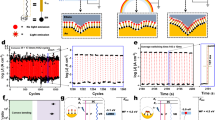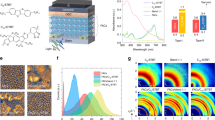Abstract
Organic semiconductors are suitable candidates for printable, flexible and large-area electronics. Alongside attaining an improved device performance, to confer a multifunctional nature to the employed materials is key for organic-based logic applications. Here we report on the engineering of an electronic structure in a semiconducting film by blending two molecular components, a photochromic diarylethene derivative and a poly(3-hexylthiophene) (P3HT) matrix, to attain phototunable and bistable energy levels for the P3HT's hole transport. As a proof-of-concept we exploited this blend as a semiconducting material in organic thin-film transistors. The device illumination at defined wavelengths enabled reversible tuning of the diarylethene's electronic states in the blend, which resulted in modulation of the output current. The device photoresponse was found to be in the microsecond range, and thus on a technologically relevant timescale. This modular blending approach allows for the convenient incorporation of various molecular components, which opens up perspectives on multifunctional devices and logic circuits.
This is a preview of subscription content, access via your institution
Access options
Subscribe to this journal
Receive 12 print issues and online access
$259.00 per year
only $21.58 per issue
Buy this article
- Purchase on Springer Link
- Instant access to full article PDF
Prices may be subject to local taxes which are calculated during checkout




Similar content being viewed by others
References
Arias, A. C., MacKenzie, J. D., McCulloch, I., Rivnay, J. & Salleo, A. Materials and applications for large area electronics: solution-based approaches. Chem. Rev. 110, 3–24 (2010).
Klauk, H., Zschieschang, U., Pflaum, J. & Halik, M. Ultralow-power organic complementary circuits. Nature 445, 745–748 (2007).
Crone, B. et al. Large-scale complementary integrated circuits based on organic transistors. Nature 403, 521–523 (2000).
Noh, Y. Y., Zhao, N., Caironi, M. & Sirringhaus, H. Downscaling of self-aligned, all-printed polymer thin-film transistors. Nature Nanotech. 2, 784–789 (2007).
Smits, E. C. P. et al. Bottom-up organic integrated circuits. Nature 455, 956–959 (2008).
Yan, H. et al. A high-mobility electron-transporting polymer for printed transistors. Nature 457, 679–U671 (2009).
Sekitani, T. et al. Stretchable active-matrix organic light-emitting diode display using printable elastic conductors. Nature Mater. 8, 494–499 (2009).
McCulloch, I. et al. Liquid-crystalline semiconducting polymers with high charge-carrier mobility. Nature Mater. 5, 328–333 (2006).
Gundlach, D. J. et al. Contact-induced crystallinity for high-performance soluble acene-based transistors and circuits. Nature Mater. 7, 216–221 (2008).
Berggren, M. et al. Light-emitting-diodes with variable colors from polymer blends. Nature 372, 444–446 (1994).
Halls, J. J. M. et al. Efficient photodiodes from interpenetrating polymer networks. Nature 376, 498–500 (1995).
Yu, G., Gao, J., Hummelen, J. C., Wudl, F. & Heeger, A. J. Polymer photovoltaic cells: enhanced efficiencies via a network of internal donor–acceptor heterojunctions. Science 270, 1789–1791 (1995).
Smith, J. et al. The influence of film morphology in high-mobility small-molecule:polymer blend organic transistors. Adv. Funct. Mater. 20, 2330–2337 (2010).
Collier, C. P. et al. Electronically configurable molecular-based logic gates. Science 285, 391–394 (1999).
Russew, M. M. & Hecht, S. Photoswitches: from molecules to materials. Adv. Mater. 22, 3348–3360 (2010).
Tsuyoshi, T. & Irie, M. Electrical functions of photochromic molecules. J. Photochem. Photobiol. C: Photochem. Rev. 11, 1–14 (2010).
Irie, M. Diarylethenes for memories and switches. Chem. Rev. 100, 1685–1716 (2000).
Kronemeijer, A. J. et al. Reversible conductance switching in molecular devices. Adv. Mater. 20, 1467–1473 (2008).
Tsujioka, T. & Masuda, K. Electrical carrier-injection and transport characteristics of photochromic diarylethene films. Appl. Phys. Lett. 83, 4978–4980 (2003).
Yoshida, M. et al. Development of field-effect transistor-type photorewritable memory using photochromic interface layer. Jpn J. Appl. Phys. 49, 04DK09-04DK09-4 (2010).
Zhang, Z. et al. A smart light-controlled carrier switch in an organic light emitting device. Adv. Funct. Mater. 18, 302–307 (2008).
Zacharias, P., Gather, M. C., Kohnen, A., Rehmann, N. & Meerholz, K. Photoprogrammable organic light-emitting diodes. Angew. Chem. Int. Ed. 48, 4038–4041 (2009).
Koshido, T., Kawai, T. & Yoshino, K. Novel photomemory effects in photochromic dye-doped conducting polymer and amorphous photochromic dye layer. Synthetic Met. 73, 257–260 (1995).
Jakobsson, F. L. E. et al. Tuning the energy levels of photochromic diarylethene compounds for opto-electronic switch devices. J. Phys. Chem. C 113, 18396–18405 (2009).
Andersson, P., Robinson, N. D. & Berggren, M. Switchable charge traps in polymer diodes. Adv. Mater. 17, 1798–1803 (2005).
Sirringhaus, H. et al. Two-dimensional charge transport in self-organized, high-mobility conjugated polymers. Nature 401, 685–688 (1999).
Burgi, L., Richards, T. J., Friend, R. H. & Sirringhaus, H. Close look at charge carrier injection in polymer field-effect transistors. J. Appl. Phys. 94, 6129–6137 (2003).
Zhang, F. et al. Energy level alignment and morphology of interfaces between molecular and polymeric organic semiconductors. Org. Electron. 8, 606–614 (2007).
Duhm, S. et al. Orientation-dependent ionization energies and interface dipoles in ordered molecular assemblies. Nature Mater. 7, 326–332 (2008).
Salzmann, I. et al. Tuning the ionization energy of organic semiconductor films: the role of intramolecular polar bonds. J. Am. Chem. Soc. 130, 12870 (2008).
Yang, H. et al. Effect of mesoscale crystalline structure on the field-effect mobility of regioregular poly(3-hexyl thiophene) in thin-film transistors. Adv. Funct. Mater. 15, 671 (2005).
Brinkmann, M. & Rannou, P. Molecular weight dependence of chain packing and semicrystalline structure in oriented films of regioregular poly(3-hexylthiophene) revealed by high-resolution transmission electron microscopy. Macromolecules 42, 1125 (2009).
Joshi, S. et al. Bimodal temperature behavior of structure and mobility in high molecular weight P3HT thin films. Macromolecules 42, 4651–4660 (2009).
Scarpa, G., Martin, E., Locci, S., Fabel, B. & Lugli, P. Organic thin-film phototransistors based on poly(3-hexylthiophene). J. Phys. Conf. Ser. 193, 012114 (2009).
Acknowledgements
This paper is dedicated to Professor Klaus Müllen on the occasion of his 65th birthday. This work was financially supported by European Community's Marie-Curie Initial Training Networks SUPERIOR (PITN-GA-2009-238177) and GENIUS (PITN-GA-2010-264694), Seventh Framework Programme FP7 ONE-P large-scale project no. 212311, European Research Council project SUPRAFUNCTION (GA-257305) and the International Center for Frontier Research in Chemistry. Generous support by the German Research Foundation (DFG via SFB 658 subproject B8 and via SPP 1355) is acknowledged. Access to UPS was granted by J.P. Rabe (Humboldt-Universität zu Berlin). BASF AG, Bayer Industry Services and Sasol Germany are thanked for generous donations of chemicals. A.S. acknowledges financial support from the National Science Foundation in the form of a CAREER Award. D.T.D. is supported by a Stanford Graduate Fellowship and the National Science Foundation Graduate Research Fellowship. Portions of this research were carried out at the Stanford Synchrotron Radiation Lightsource, a national user facility operated by Stanford University on behalf of the Office of Basic Energy Sciences, US Department of Energy.
Author information
Authors and Affiliations
Contributions
S.H. and P.S. conceived the experiments and designed the study. M.H., M.P. and L.G. carried out the synthesis as well as photochemical and electrochemical characterization. E.O. and N.C. performed the device experiments. E.O., G.B. and E.P. designed and performed the time-response measurements. J.F. carried out the UPS measurements. D.T.D. and A.S. performed the grazing incidence X-ray diffraction experiments. All authors discussed results and contributed to the interpretation of data. E.O., P.S., N.K. and S.H. co-wrote the paper. All authors contributed to editing the manuscript.
Corresponding authors
Ethics declarations
Competing interests
The authors declare no competing financial interests.
Supplementary information
Supplementary information
Supplementary information (PDF 2581 kb)
Rights and permissions
About this article
Cite this article
Orgiu, E., Crivillers, N., Herder, M. et al. Optically switchable transistor via energy-level phototuning in a bicomponent organic semiconductor. Nature Chem 4, 675–679 (2012). https://doi.org/10.1038/nchem.1384
Received:
Accepted:
Published:
Issue Date:
DOI: https://doi.org/10.1038/nchem.1384
This article is cited by
-
Photo Switchable Two-step Photochromism in a Series of Ln-Phosphonate(Ln=Dy, Gd, Tb, Y) Dinuclear Complexes
Chemical Research in Chinese Universities (2022)
-
Multifunctional devices based on planar microsupercapacitors: Progress and challenges
Science China Materials (2022)
-
Reduced contact resistance in organic field-effect transistors fabricated using floating film transfer method
Journal of Materials Science: Materials in Electronics (2020)
-
Novel Photoswitchable Dihetarylethenes Exhibiting Fluorescence
Journal of Fluorescence (2020)
-
Optically switchable organic light-emitting transistors
Nature Nanotechnology (2019)



